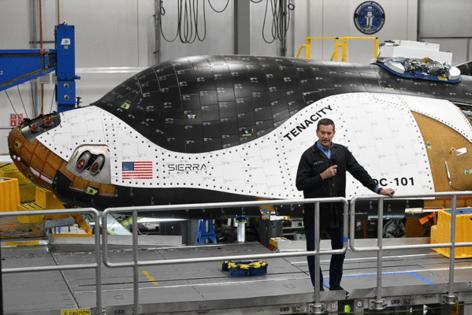Sierra Space Dream Chaser's NASA deal upended, 1st flight pushed to late 2026
Published in News & Features
Sierra Space had been looking to join SpaceX and Northrop Grumman as one of three commercial resupply partners for NASA aiming to fly its Dream Chaser spacecraft to the International Space Station.
But now Dream Chaser won’t be guaranteed any flights to the space station after NASA and Sierra Space mutually agreed to adjust the contract.
The Dream Chaser spacecraft made it to Kennedy Space Center in spring 2024 and had been aiming to fly on the second-ever launch of United Launch Alliance’s Vulcan later that year. But issues after testing forced its ride to space to move on without them.
Now, Sierra Space and NASA have changed their deal so Dream Chaser’s first flight will be a free flyer, not hooking up with the space station. And because of ULA’s growing manifest including priority national security missions, the next available Vulcan won’t come until late 2026.
“Development of new space transportation systems is difficult and can take longer than what’s originally planned,” said NASA’s Dana Weigel, manager of the space station program. “The ability to perform a flight demonstration can be a key enabler in a spacecraft’s development and readiness, as well as offering greater flexibility for NASA and Sierra Space.”
Dream Chaser looks like a miniature space shuttle, but is about one quarter the size. Sierra Space had originally won the NASA’s Commercial Resupply Services 2 contract back in 2016 with Dream Chaser awarded seven cargo flights to the space station joining previous commercial contract winners SpaceX with its cargo Dragon and Northrop Grumman, formerly Orbital ATK, with its Cygnus spacecraft.
But now, NASA will provide minimal support to the remainder of Dream Chaser’s development and first flight. NASA can still order Dream Chaser resupply flights if the first test flight is successful.
“As NASA and its partners look toward space station deorbit in 2030, this mutually agreed to decision enables testing and verification to continue on Dream Chaser, as well as demonstrating the capabilities of the spaceplane for future resupply missions in low-Earth orbit,” Weigel said.
Sierra Space had initially tried to win a contract for a human-rated version of Dream Chaser, but NASA opted to give those commercial contracts to SpaceX for Crew Dragon and Boeing for its Starliner.
The company still aims to develop a human-rated version of the vehicle that could be used to fly to any of the commercial space stations in development that look to replace the International Space Station once it’s decommissioned.
Tom Vice, then CEO of Sierra Space, talks to hundreds of employees in front of the Dream Chaser to thank them for all of their hard work at Sierra Space on October 30, 2023 in Louisville, Colorado. (Helen H. Richardson/The Denver Post) The first Dream Chaser is named Tenacity.
Unlike SpaceX, which has Dragon landings in the water, and Cygnus, which burns up in Earth’s atmosphere after the station is done with it, Dream Chaser is designed to land back on Earth in the same way the space shuttle orbiters did.
Its first missions would target a return at Kennedy Space Center at the former space shuttle landing facility.
The spacecraft has been in the works for more than 15 years.
The vehicle to date has only made successful drop tests outside of Florida from high altitudes to show its ability to land safely. In 2024, it completed months of testing at NASA’s Neil Armstrong Test Facility in Ohio before it made its way to Kennedy Space Center.
The unmanned, 30-foot-long vehicle can deliver up to 12,125 pounds of supplies and can remain attached to the ISS and become an extension of the workable space. The roadmap calls for a crew version configuration with room up to seven crewmembers and supplies.
Sierra Space had already partnered with Blue Origin to pursue a commercial space station called Orbital Reef, and the Dream Chaser could become an essential crew and cargo spacecraft for it.
The company also says the pivot to a free-flying demonstration would allow it to be considered for use on future national security and defense demonstrations.
“Dream Chaser represents the future of versatile space transportation and mission flexibility,” said Fatih Ozmen, Sierra Space’s executive chair. “This transition provides unique capabilities to meet the needs of diverse mission profiles, including emerging and existential threats and national security priorities that align with our acceleration into the defense tech market.”
Ozmen touted the spacecraft’s adaptability for rapid deployment as well as the ability to land on any conventional runway, allowing for rapid turnaround and reusability.
“Together with NASA, we are seeking to preserve the exceptional potential of Dream Chaser as a national asset, ensuring its readiness for the next era of space innovation,” he said.
_____
©2025 Orlando Sentinel. Visit at orlandosentinel.com. Distributed by Tribune Content Agency, LLC.







Comments